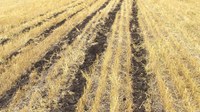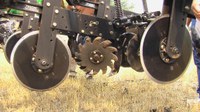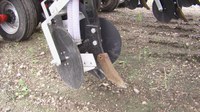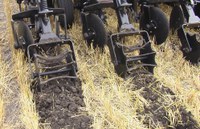NDSU Offers Help to Find the Right Strip-till Equipment
(Click an image below to view a high-resolution image that can be downloaded)
Strip-till is a field tillage system that combines no-till and full tillage to produce row crops. Narrow strips, 8 to 12 inches wide, are tilled into crop stubble, but the area between the rows is left undisturbed. Next year’s crop is planted into the tilled rows.
“Generally, strip-till equipment is designed for varying distances between rows so the tilled area corresponds to planter widths,” says John Nowatzki, North Dakota State University Extension Service agricultural machine systems specialist. “Strip-till saves energy because only part of the soil is tilled. It has the potential to reduce erosion, compared with full tillage because most of the soil remains covered with crop residue. It also keeps the advantages of tilled soil in crop production through faster soil warming and drying in the spring.”
Strip-tilling normally is done in the fall after harvest, but it also can be done in the spring before planting. Strip-till equipment normally includes a system to inject fertilizer.
Strip-till demonstration videos and Internet links to strip-till equipment manufacturers are available on the Web at http://www.ag.ndsu.nodak.edu/abeng/geospatial/striptill.htm. Several equipment manufacturers market strip-till machines, but most have similar features including coulter blades, row cleaners, tillage shanks, berm-building disks and packing wheels or conditioning baskets.
The coulter blade cuts through the soil and residue in front of the tillage shank. Coulters need to be spring-mounted to allow movement over stones. Some manufacturers are using fluted coulters designed with depth-control features. Residue managers function to clear crop residue away from the tilled strip. Various manufacturers use unique designs to clean the area. The row cleaners usually are mounted a few inches in front of the coulter blade to move the crop residue which allows the coulter to penetrate the soil. Some manufacturers mount the row cleaners behind the coulter and just in front of the tillage shank.
The tillage shank penetrates and loosens the soil and can be designed with a fertilizer injection tube so gaseous, liquid or dry granular fertilizers can be applied with the strip-tillage operation.
Tillage depth is dependent on the type of soil and conditions and the specific crop that will be planted. Berm-building disks are mounted on each side of the tillage shank and 6 to 8 inches behind the shank. The disks can be mounted to mound the strip to promote moisture runoff and facilitate soil drying in the spring or to create a slight depression in the soil to catch snow and rain to increase soil moisture for next year’s crop.
A conditioning basket is mounted behind each shank to break soil clods and smooth the soil. Some manufacturers use rubber wheels instead of packing wheels, but some way of smoothing the soil and breaking lumps is important on strip-till equipment. All the components of a strip-till machine usually are mounted on a tool bar.
Strip-till equipment requires approximately 15 to 20 tractor horsepower per strip, but varies depending on component design and depth of operation.
“A primary concern of strip-tilling is to precisely plant into the strips the following spring,” Nowatzki says. “Strip-tillage machines can be equipped with markers to facilitate accurate spacing of rows on each round in the field. However, using precise global positioning system (GPS) guidance likely will result in more consistent planting in the rows. The GPS accuracy must be within the tolerances of the strip-tilled width, which is easily achievable with real-time kinematic differential correction, but more difficult with less precise GPS differential correction services.”
NDSU Agriculture Communication
| Source: | John Nowatzki, (701) 231-8213, john.nowatzki@ndsu.edu |
|---|---|
| Editor: | Rich Mattern, (701) 231-6136, richard.mattern@ndsu.edu |





